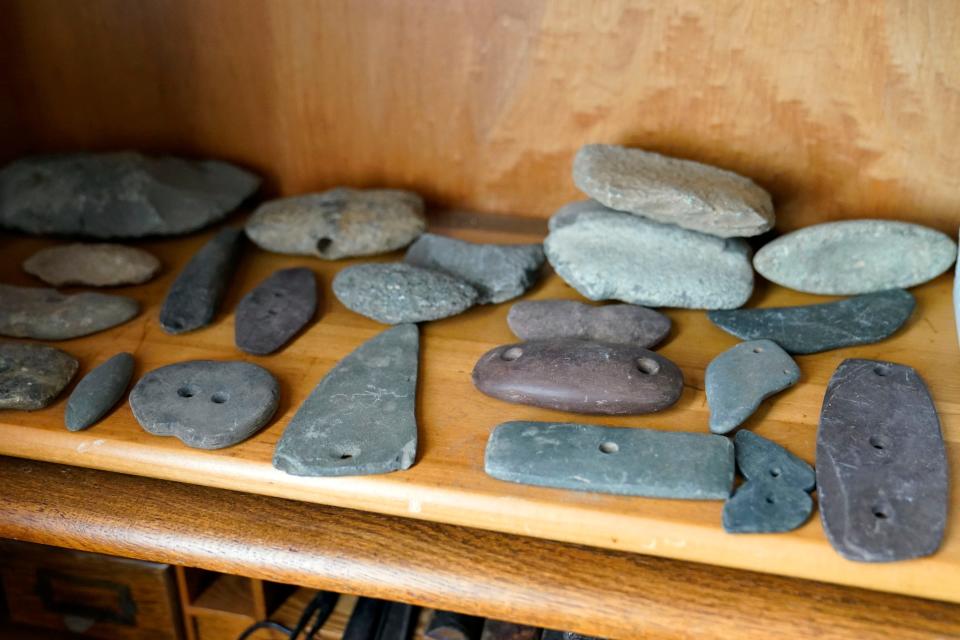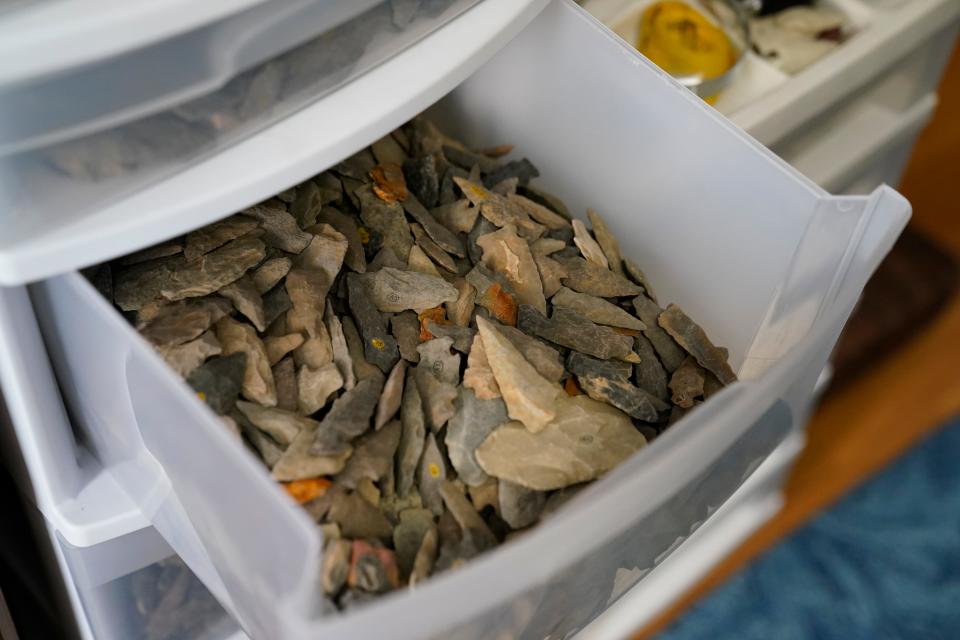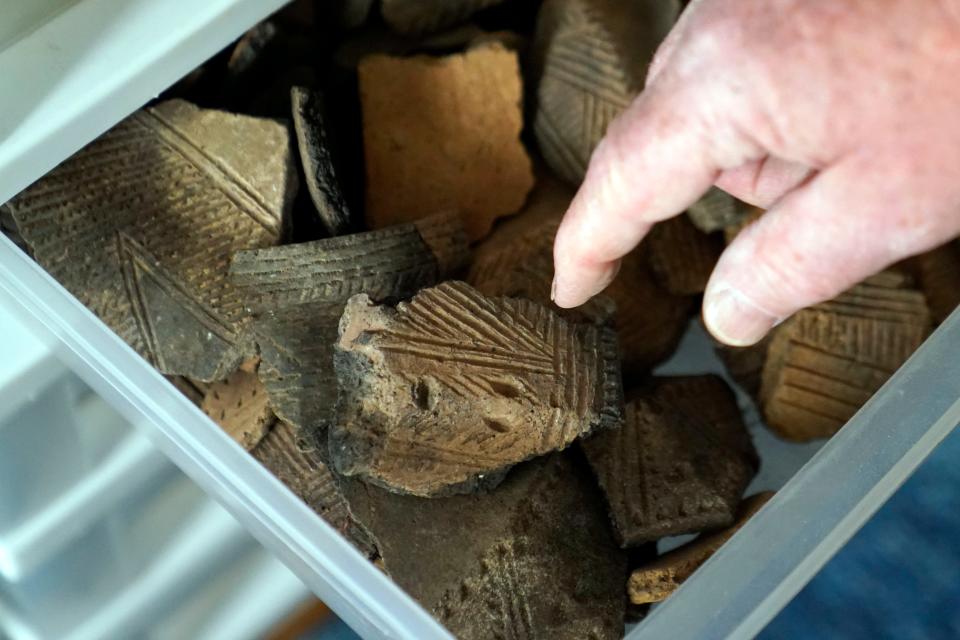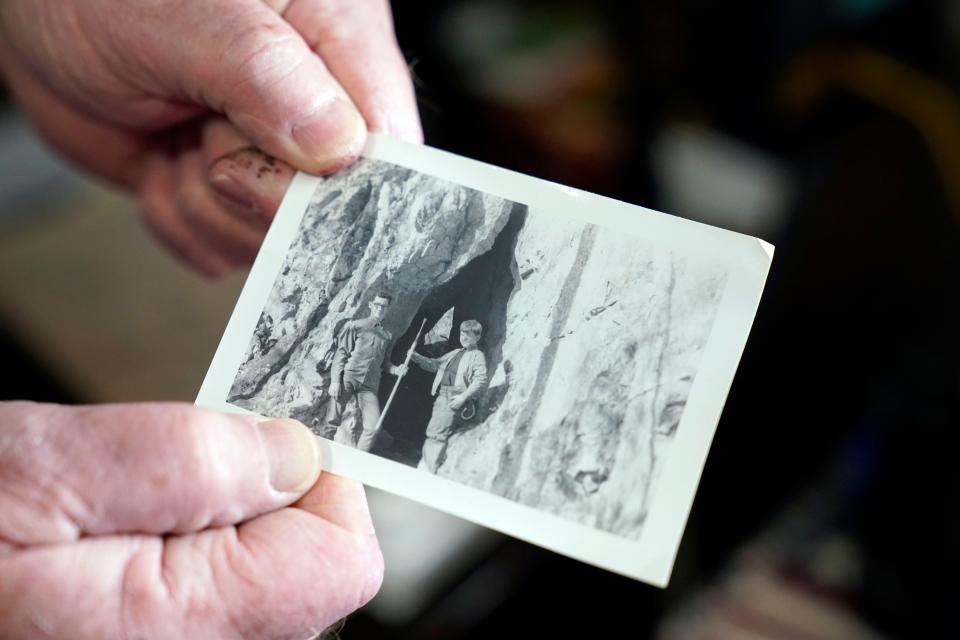Passaic County brothers value 'one in a million' collection of Native American relics
- Oops!Something went wrong.Please try again later.
WAYNE — Wilfred Grotz and his brother, Frederick, inherited a gift from their father that cannot be bought or duplicated.
It is an innate sense, they said, to be able to survey any chunk of land in the valley and to know whether it can yield the Native American relics of their fancy.
Over the span of decades, the brothers and their father, the late Gustav C. Grotz, harvested hundreds of arrowheads, cutting blades and other collectible stones from this area. They went on hours-long jaunts to construction sites where excavators had delved into the virgin earth and to the peripheries of vast farms where no one would notice them.
There were frequent rendezvous to Wihlahoosa Cave in Port Jervis, New York, and to nearby locations — including to the southern tip of Lincoln Park, where two rivers meet. These grounds once teemed with Lenni Lenape artifacts, the brothers said.

Frederick “Rick” Grotz, 70, of Totowa, said he remembered picking up arrow points “like candy” at this one spot as if someone smacked a piñata.
“You can almost picture what it was like 200 years ago, when you’re sitting on that same bluff as the Indian was,” said Wilfred “Bill” Grotz, 66, of Wayne.
In October 2019, Bill and his wife moved from Totowa to a home on Ruskin Court.
They brought with them the family’s entire collection of artifacts, most stored in milk crates that are stacked against a wall in their two-car garage. Some are neatly lined up on bookshelves in a spare bedroom that Bill, a retired supervisor for the state Motor Vehicle Commission, uses as an office.
The elder Grotz, who died at 87 years old in March 2000, was scrupulous. The artifacts that he found were marked with alphanumeric codes, which corresponded to coordinates on a set of maps. He cataloged every single piece. The hobby consumed his life, his sons said.
CASUAL DINING: Grand opening of PrimoHoagies in Wayne to feature free subs and 'Real Housewives' stars
As a curious boy, Rick said he often sneaked a look inside of his father’s old dentist’s cabinet. “You’d pull the drawers out,” he said, “and there’d be nothing but arrowheads — nothing but arrowheads, drawer after drawer.”
It began with just one arrowhead.

Their father found it, the brothers said, when he hiked at Garret Mountain in 1924, seven years before the 568-acre expanse became a reservation owned by Passaic County.
Their father soon began to volunteer at Paterson Museum, now on Market Street, where the brothers said he met Max Schrabisch, a German immigrant and a professional archaeologist who passed on his knowledge.
As the collection approaches 100 years old, the brothers said they wonder what can be done with it to preserve their father’s legacy and to honor the indigenous people who scattered the pieces over the area so many generations ago.
“Once this stuff is gone, it’s gone,” Bill said. “You’ll never see it again. It’s one in a million.”
‘Ain’t making that stuff no more’
The territory inhabited by the Lenape included all of New Jersey, and portions of the Hudson Valley in New York and the Lehigh Valley in Pennsylvania. By the latter decades of the 18th century, most of the Lenape were displaced by European settlers. Two of the state’s three modern-day tribes descended from them.
Bill’s latest discovery of what he believes to be a Lenape artifact came this past spring, he said, at a swath on Route 23 south, where a developer felled more than 350 trees for the construction of apartments and two commercial buildings.
Lay observers would have easily overlooked the piece, but Bill noticed its flat surface and other telltale marks that suggest the stone was, as the brothers say, “worked.”
“No natural rock would be like that,” Rick said.
None of this impresses their wives all that much.

Bill’s wife, Susan, has warned in a playful tone that the whole collection will be dumped in the river. “They tolerate us,” Rick said. “Let’s put it that way.”
It is funny, then, how the brothers met their wives — who happen to be sisters — after continually hunting for artifacts at their family’s property on Hollywood Avenue in Fairfield.
That was 1966. Five years later, when Bill was 14 years old, he met Susan Eschenroeder at Willowbrook Mall and later realized that she was the same girl who lived where he and his brother used to look for collectibles. Eventually, he introduced Rick to Susan’s sister, Diane.
In those days, the brothers said, the artifacts and the sites they visited to search for them were plentiful.
“Any property that you go on now, someone owns,” Bill said. “But back then, it didn’t seem to be like that. No one said nothing.”

The brothers said they believe theirs is the largest collection of Native American artifacts in the county, perhaps in the state. “They ain’t making that stuff no more,” Rick said.
In December 2004, the brothers donated a small portion of the collection in memory of their father to the Dwight D. Eisenhower Public Library on Totowa Road in Totowa. The pieces are still on view in a display case there. They are considering future donations to other libraries to spread the collection across the region, in a sort of way to give back to the land that gave to them.
But that would be hard, they admit. “What do you call that, when you have a connection?” Bill said. “Like, it’s part of him.”
The connection is in the blood.
“He knew so much about it,” Bill said of his dad. “Someone would graduate from school with a degree, but as far as right here and right now, he knew where the places were.”
Philip DeVencentis is a local reporter for NorthJersey.com. For unlimited access to the most important news from your local community, please subscribe or activate your digital account today.
Email: devencentis@northjersey.com
This article originally appeared on NorthJersey.com: North Jersey brothers value 'one in million' collection

